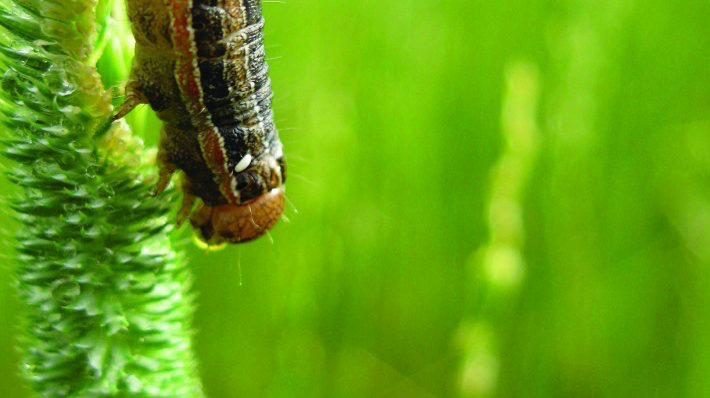Knowing when, where and how to scout is key to protecting yield from true armyworm.
True armyworm undergoes complete metamorphosis from egg to larvae, pupa and adult moth. It’s the larvae that eat corn, wheat and forage crops.
A true armyworm infestation can cause significant crop damage. But crop damage doesn’t necessarily equal yield loss. For instance, up to 75% defoliation can occur in wheat without yield loss. But if the flag leaf is damaged or if defoliation occurs prior to or during anthesis, it’s more likely to be economical to spray an insecticide if thresholds are reached.
When to scout
There can be up to three generations of true armyworm but the first generation causes the most trouble in Ontario.
Start scouting for true armyworm in late May. Get into the field at dusk as true armyworms are nocturnal. If you see damage to crops during the day, unroll emerging leaves to see if you can find larvae hiding within the leaf. Larvae can also be found under surface litter. The larvae feed for approximately one month.
True armyworm larvae will start feeding on leaf edges but move up the plant as to feed on kernels. They can even clip off the head of wheat plants.
Check in often with Tracey Baute’s bug blog. She regularly interprets data from the Great Lakes and Maritimes Pest Monitoring Network (GLMPMN), an early warning system for Ontario growers showing when infestations of true armyworm moths are blowing across the province.
How to identify true armyworm
Full grown true armyworm larvae are 1-1⁄2 inches long and are dull-green to brown in colour. They always have white-bordered stripes running laterally along the body and to be true armyworm larvae, they must have dark diagonal bands at the top of each abdominal chubby proleg.
When you’re scouting, take time to look for tiny white eggs attached to the larvae. These eggs are a good sign – they mean that the true armyworm in your field have been parasitized by wasps or flies. Avoid treating with insecticides if large numbers of the larvae have been parasitized as they’re going to die anyway.

Where to scout in corn and wheat
In corn, examine 20 plants in five areas in the field (100 plants total). In cereals and mixed forages, examine 10 areas of the field, assessing the number of larvae per square foot.
You should consider spraying if you find four un-parasitized larvae per square foot. The larvae should be smaller than 2.5 cm. Ignore larvae larger than that as they will soon stop feeding. Another reason to spray is if the larvae are clipping a significant number of wheat heads, still actively feeding and under 2.5 cm in length. Just watch that pre-harvest intervals haven’t been reached.
Coragen® MaX insecticide – effective control, minimal impact on beneficials
You want to keep beneficial insects working for you in the field. Consider using Coragen® MaX insecticide if economic thresholds for true armyworm are reached. It has reliable, consistent, long-lasting protection against key insects, including true armyworm, with minimal impact on many important beneficial species and pollinators.
Resources
Tracey Baute Bug Blog
Integrated Pest Management, University of Missouri. https://ipm.missouri.edu/pestmonitoring/taw/taw.pdf
